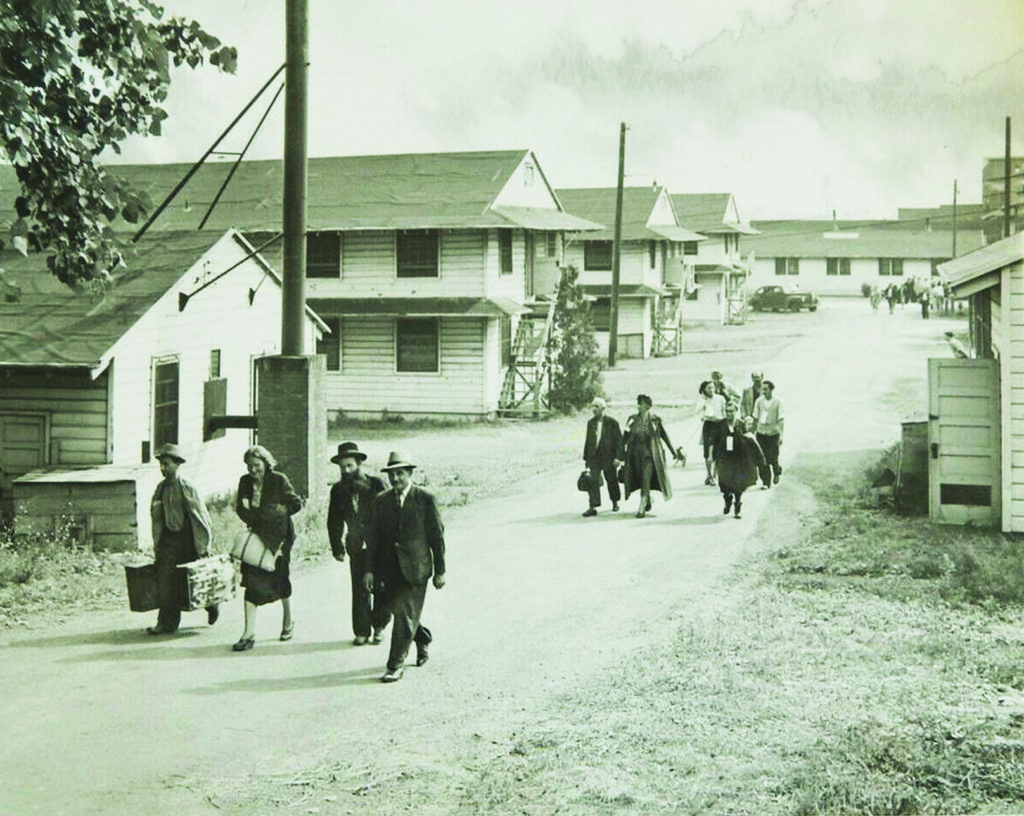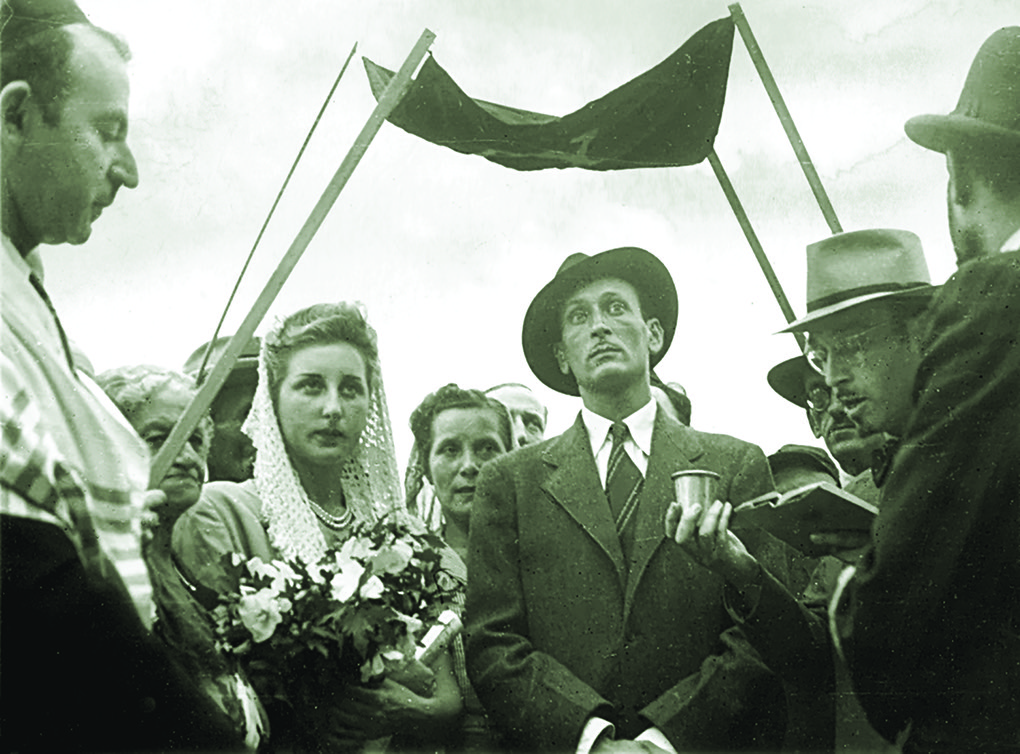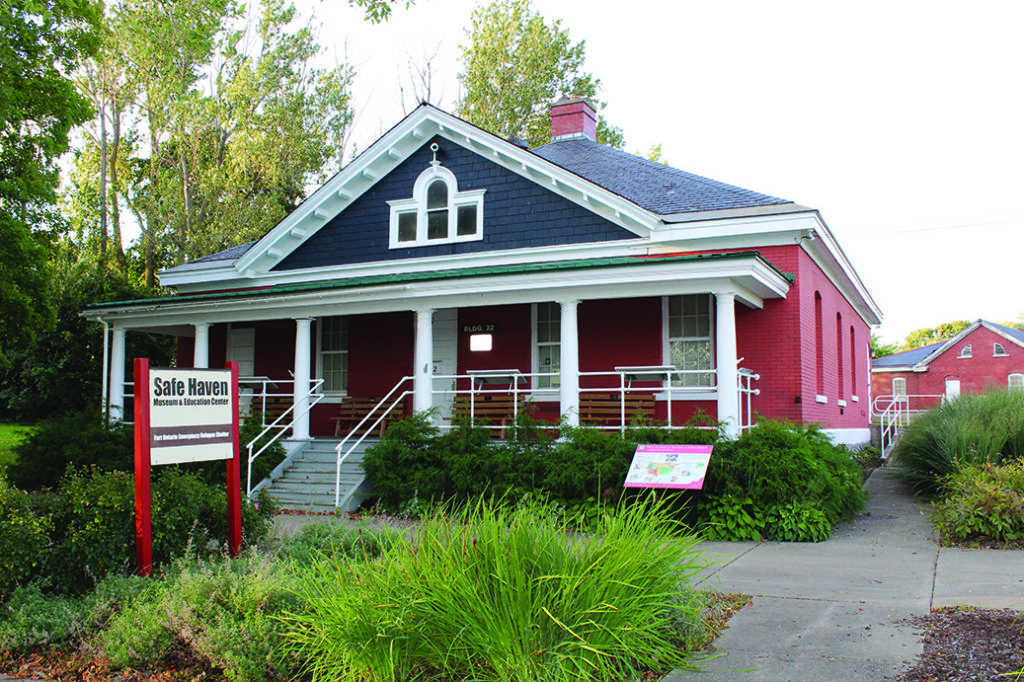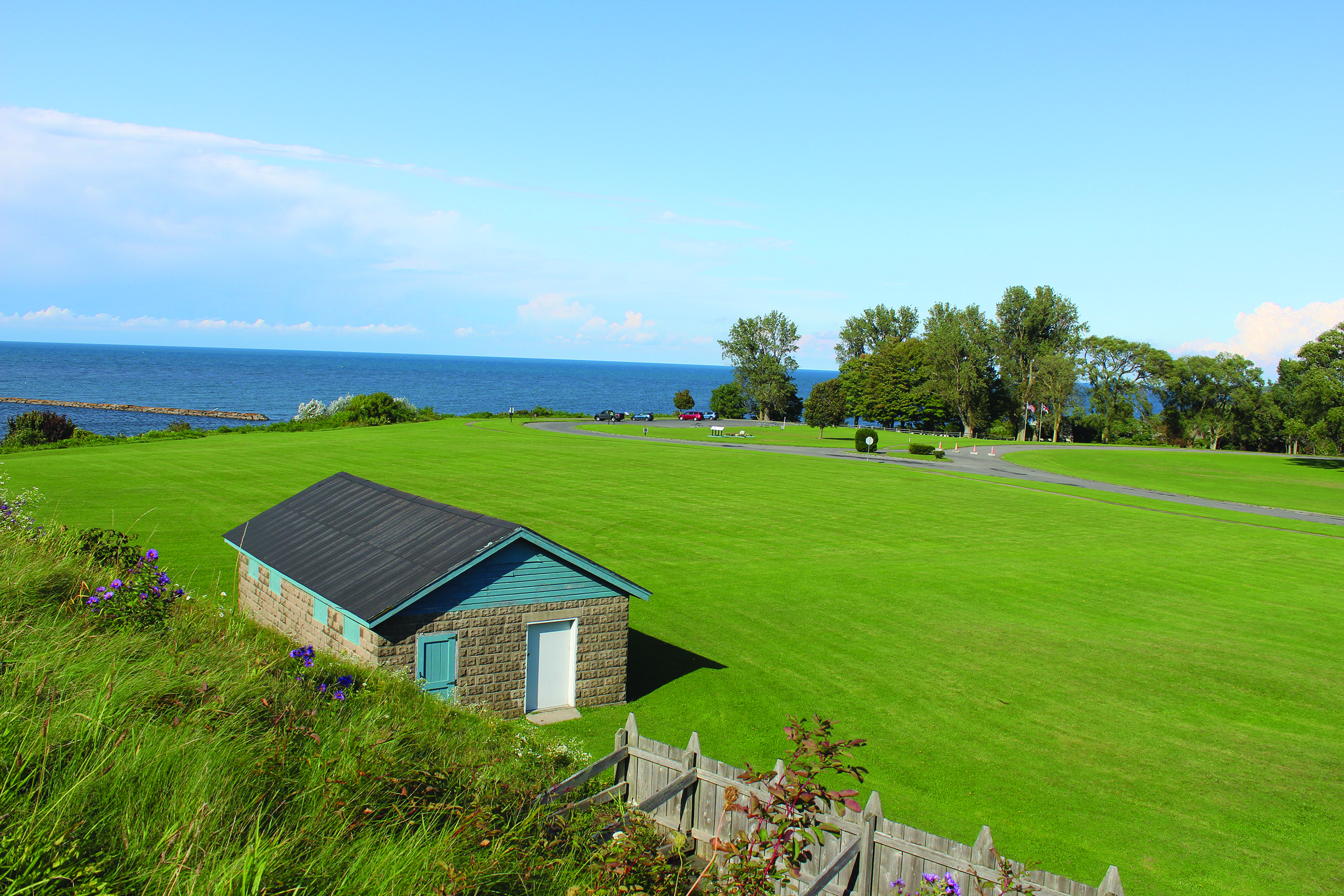During World War II, displaced people from 17 different countries forged new lives in America.
ON AUGUST 5, 1944, Manya Hartmayer, a 21-year-old German-born Jewish woman who had survived five Nazi concentration camps, stepped down from a westbound Delaware, Lackawanna & Western railcar in Oswego, New York. Like all of the 982 refugees emerging into that sunlit Saturday morning, she had spent years on the run. For the next 18 months, she would know safety and stability at nearby Fort Ontario, the only Emergency Refugee Shelter the United States established during World War II.
Seventy-five years and a few weeks later, I retrace Manya’s path from the idle railroad tracks, around the cement foundation of a long-demolished factory, to where she entered the shelter at the corner of Oswego’s East Ninth and Mercer streets. The border of what is now Fort Ontario State Historic Site has retreated a hundred yards to the west in the intervening years. Today all is quiet on this lonely street corner save the ever-present wind gusting off of Lake Ontario and rustling the neighborhood poplar trees, yet I can imagine the mix of relief and anxiety that filled the refugees as cheering locals and media flashbulbs welcomed them to relative freedom in this blue-collar town across the lake from Canada.
After confirmed reports of Nazi atrocities reached the United States in late 1942, President Franklin D. Roosevelt’s government struggled to balance the humanitarian needs of Europe’s persecuted with strict U.S. immigration quotas, public fifth-column fears, and the demands of a two-front war. In January 1944, Roosevelt created the War Refugee Board, which aided refugees in Europe and championed the establishment of an Emergency Refugee Shelter in the United States to quarter some of the displaced—and challenge other Allied nations to do the same. On June 9, Roosevelt announced that up to 1,000 European refugees in overflowing camps in Italy would be brought to America. While the Board set to work selecting refugees who met their criteria—dire need, no contagious diseases or partisan affiliations, and willingness to return to Europe after the war—the army prepared their destination.
The British had erected star-shaped Fort Ontario on the shore of its namesake lake and the Oswego River to protect vital shipping lanes during the 18th-century French and Indian War. Their French adversaries seized and demolished the fort, launching a pattern of rebuilding and razing that spanned nearly a century and three major wars. The U.S. Army erected the current structure in 1839 and, during its stint as a Union Army induction center during the Civil War, fortified its timber walls with rough gray stone. In 1903 Fort Ontario was expanded into a 75-acre military reservation to house and train full battalions, but in March 1944 the army deemed it too small for a useful wartime base and locked the gates. Fearing a hefty blow to the local economy, Oswego’s 22,000 citizens dispatched a committee to Washington, D.C., in the spring of 1944 to plea for the fort’s reopening. The army soon found an opportune way to oblige.

It took just six weeks and $250,000 to convert the fort into a shelter for the refugees, who ranged in age from three weeks to 80 years and hailed from 17 different countries. Local subcontractors partitioned 30 standard white wooden barracks into plain apartments for families with children. Dormitories were prepared for single men and women. To complement the army’s austere furnishings, relief groups donated bedspreads, cribs, and kosher flatware—89 percent of the refugees were Jewish. The army turned the finished facilities over to the War Relocation Authority (WRA), the federal agency that also managed the wartime internment of Japanese American civilians, a week before the refugees’ August 5 arrival.
Entering the site from the south, I encounter one of a handful of red-brick buildings still standing from the military and shelter days, a stately former guard shack that now chronicles the refugees’ experience as the Safe Haven Museum and Education Center. From its white-columned porch, I survey the park-like expanse of the fort, dotted with a network of interpretive signs maintained by the New York State Parks, Recreation and Historic Preservation crew that manages the site from the old stone garrison in the distance.
Exchanging pleasantries with early rising joggers, I follow a receding stone path across the lush green former parade grounds where WRA Director Dillon Myer welcomed the refugees to their temporary home. Monarch butterflies dart to and fro where children who had lived for years in silent hiding forged cross-lingual friendships with the aid of that universal translator, the baseball. I round first base of a diamond where they played—today in use by Oswego Little Leaguers—and pause in the soft grass of right-center field. Here, just 12 days after the refugees’ arrival, young Manya joyfully wed Ernst Breuer, a 26-year-old Austrian she had met aboard the army transport ship that brought them from Naples to New York.

In an effort to make the shelter as self-sufficient as possible, the War Refugee Board had selected adults with a variety of occupations. Doctors, rabbis, tailors, and others who labored in the shelter earned $18 a month, while their non-working counterparts received smaller stipends. Two dozen of the refugees were artists and the army erected studios at the north end of the fort, where expansive views of Lake Ontario inspired beautiful creations in clay, ink, and oil. Bewitched by the artists’ muse, I rest on a bench where the studios once stood and watch a near-cloudless sky quickly give way to a wall of angry thunderheads. I escape to my car just before pea-size hail begins ricocheting three feet off the pavement.
In some ways, the refugees’ experience was as volatile as Oswego’s weather. While grateful for the refuge, they were keenly aware of the eight-foot chain-link and barbed-wire fence surrounding them. Through the few hundred rusty feet of fence that remains, I watch the downtown streets come alive in the distance for the weekly farmers’ market. The first large group of refugees ever welcomed to the United States, the shelter residents were temporary guests of the president with ambiguous legal status. After a 30-day quarantine, 193 children were invited to attend public schools. Adults were limited to six-hour passes to visit Oswego.
The fence hardly kept the two worlds apart. Locals hoisted everything from bicycles to Ping-Pong balls over these wires, and teenagers found holes to accommodate moonlit fraternization. Eager to ease cultural divides, hundreds of refugees attended the shelter’s English classes and studied its weekly newsletter, the Ontario Chronicle, for tips like Fahrenheit-Celsius conversions and the meaning of Thanksgiving.

The refugees celebrated with the town when six of their own graduated with the Oswego High School class of 1945 and mourned with them when news broke of President Roosevelt’s death. Dodging puddles in the dank tunnel through the old fort’s stone redoubt, I emerge on the pristine lawn where the all-refugee Ontario Orchestra and Yugoslavian opera baritone Leo Mirkowicz performed tributes to the late president in the long shadows of century-old officers’ quarters and storehouses, now filled with exhibits of the fort’s Civil War days.
When the war in Europe ended, most of the refugees dreaded the return to their ravaged homelands. Peering through the foggy windows of the long-abandoned Post Exchange, I see the paint-chipped stairs that shelter staff and local leaders climbed on June 25, 1945, to testify at a U.S. House Subcommittee on Immigration and Naturalization hearing to determine the refugees’ fate. The subcommittee ultimately ruled that the refugees should be allowed to remain in the United States. President Truman concurred on December 22. By then, 69 refugees had voluntarily returned to Europe. In the bitter cold of January and February 1946, those remaining were bused across the Canadian border at Buffalo in order to reenter the United States with legal immigrant status. Carrying few possessions and too many painful memories, they dispersed into postwar America.
In April 1946, Fort Ontario was transferred to the state of New York, which eased a postwar housing shortage by accommodating veterans and their families here until 1953. After their departure, all but a few of the army facilities were dismantled, and the land divided for use by the city of Oswego, the Army Reserves’ 479th Engineer Battalion, and the historic site. More than 200,000 people visit the latter each year, many of them treated to notoriously dramatic Oswego sunsets like the one that concludes my stay. As vibrant bands of orange and pink plunge into Lake Ontario, I think of Manya and her words at a 50th-anniversary gathering to commemorate the shelter: “Here I started to live again.” ✯
WHEN YOU GO
Located 30 miles north of Interstate 90, the city of Oswego is an easy drive from the Syracuse, Rochester, and Buffalo airports. Fort Ontario State Historic Site is open to visitors May through October.
Where to Stay and Eat
A half-dozen hotels overlook the Oswego River just a few blocks from the fort. If you’d prefer one of the charming area bed-and-breakfasts, set one morning aside to endure the line at Wade’s (tel. 315-343-6429), a cash-only diner that makes delicious cinnamon raisin bread and a killer—if odiously named—“garbage omelet.” Locally beloved Rudy’s Lakeside Drive-In (closed in winter) serves seafood plate lunches and homemade ice cream sandwiches.
What Else to See and Do
After the Safe Haven Museum and Education Center and a self-guided tour through the many eras of old Fort Ontario, cross the river to the H. Lee White Maritime Museum, whose fleet of historic vessels includes a D-Day tugboat from the makeshift American harbor off Normandy. For a taste of the War of 1812, make the hour drive up to Sackets Harbor Battlefield State Historic Site. Continue north to explore the idyllic communities of the Thousand Islands region.
This article was published in the June 2020 issue of World War II.

